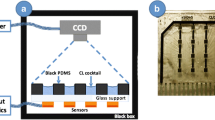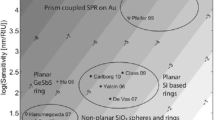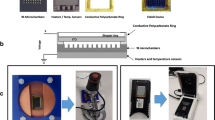Abstract
Silicon nanowire-based (SiNW) biosensors have gained a lot of attention during recent years. However, studies often totally neglect, or only briefly describe, the incorporation of microfluidic channel into the sensor architecture, although it is a crucial step towards a real lab-on-chip device. This paper proposes a process that can be applied to integration of microfluidic sample delivery system onto different SiNW biosensors. The sample delivery system includes a hydrophilic channel that enables the use of capillary action in delivering sample directly onto the sensor array, which leads to reduced sample loss, faster detection process, and frees from the use of external pumps. In addition, the microfluidic channel system protects the fragile SiNWs from mechanical shocks, chemical spatters, and dust. The sample delivery system was fabricated of surface treated polydimethylsiloxane (PDMS), using a four-step approach, as follows: (1) master molds for soft lithography were etched onto Si. (2) PDMS replicas of the molds were fabricated and (3) bonded onto example sensor chips using oxygen plasma. (4) Oxygen plasma treatment also enabled the attachment of polyvinylpyrrolidone (PVP) to the sample channel surfaces to synthesize hydrophilic polymer coating. A contact angle for the PVP treated PDMS was 21 after 17 days, indicating the formation of a long-term hydrophilic PDMS surface. Finally, the example SiNW sensor is modified to allow direct real-time detection of thyroid-stimulating hormone (TSH). The sensor was able to detect as low TSH concentration values as 0.5 mIU/l, which indicates a successfully integrated sample delivery system.











Similar content being viewed by others
References
de Menezes Atayde C, Doi I (2010) Highly stable hydrophilic surfaces of PDMS thin layer obtained by UV radiation and oxygen plasma treatments. Phys Status Solidi C 7:189–192
Folttmann H, Quadir A (2008) Polyvinylpyrrolidone (PVP)—one of the most widely used excipients in pharmaceuticals: an overview. Drug Deliv Technol 8:22–27
Gao Z, Agarwal A, Trigg AD, Singh N, Fang C, Tung C-H, Fan Y, Buddharaju KD, Kong J (2007) Silicon nanowire arrays for label-free detection of DNA. Anal Chem 7:3291–3297
Gao A, Lu N, Dai P, Li T, Pei H, Gao X, Gong Y, Wang Y, Fan C (2011) Silicon nanowire-based CMOS-compatible field-effect transistor nanosensors for ultrasensitive electrical detection of nucleic acids. Nano Lett 11:3974–3978
Hahm J-In, Lieber CM (2004) Direct ultrasensitive electrical detection of DNA and DNA sequence variations using nanowire nanosensors. Nano Lett 4:51–54
Haycock JW (1993) Polyvinylpirrolidone as a blocking agent in immunochemical studies. Anal Biochem 208:397–399
Hemmilä S, Chauiz-Rodríguez JV, Kreutzer J, Kallio P (2012) Rapid, simple, and cost-effective treatments to achieve long-term hydrophilic PDMS surfaces. Appl Surf Sci 258:9864–9875
Lin Z-H, Shen G-L, Miao Q, Yu R-Q (1996) A thyroid-stimulating hormone immuno-electrode. Anal Chim Acta 325:87–92
Liu Y, Wang C, Chen J, Wu X, Wang H, Dong P, Di D (2013) Interdigitated microelectrodes biosensor with nanodot arrays for thyroid-stimulating hormone detection. Micro Nano Lett 8:11–14
Maheshwari N, Kottantharayil A, Kumar M, Mukherji S (2010) Long term hydrophilic coating on poly(dimethylsiloxane) substrates for microfluidic applications. Appl Surf Sci 257:451–457
McDonald JC, Duffy DC, Anderson JR, Chiu DT, Wu H, Schueller OJ, Whitesides GM (2000) Fabrication of microfluidic systems in poly(dimethylsiloxane). Electrophoresis 21:27–40
Ng JMK, Gitlin I, Stroock AD, Whitesides GM (2002) Components for integrated poly(dimethylsiloxane) microfluidic systems. Electrophoresis 23:3461–3473
Sharma G, Liljeholm L, Enlund J, Bjurström J, Katardjiev I, Hjort K (2010) Fabrication and characterization of a shear mode AlN solidly mounted resonator-silicone microfluidic system for in-liquid sensor applications. Sensors Actuators A 159:111–116
Stern E, Klemic JF, Routenberg DA, Wyremebak PN, Turner-Evans DB, Hamilton AD, LaVan DA, Fahmy TM, Reed MA (2007) Label-free immunodetection with CMOS-compatible semiconducting nanowires. Nature 445:519–522
Tabata O, Asahi R, Funabashi H, Shimaoka K, Sugiyama S (1992) Anisotropic etching of silicon in TMAH solutions. Sensors Actuators A 34:51–57
Tey JN, Wijaya IPM, Wei J, Rodriguez I, Mhaisalkar SG (2010) Nanotubes-/nanowires-based, microfluidic-integrated transistors for detecting biomolecules. Microfluid Nanofluid 9:1185–1214
Vlachopolou M-E, Petrou P, Kakabakos S, Tserepi A, Beltsios K, Gogolides E (2009) Effect of surface nanostructuring of PDMS on wetting properties, hydrophobic recovery and protein adsorption. Microelectron Eng 86:1321–1324
Wang WU, Chen C, Lin K-hui, Fang Y, Lieber CM (2005) Label-free detection of small-molecule—protein interactions by using nanowire nanosensors. PNAS 102:3208–3212
Wang L, Sun B, Ziemer KS, Barabino GA, Carrier RL (2010) Chemical and physical modifications to poly(dimethylsiloxane) surfaces affect adhesion of Caco-2 cells. J Biomed Mater Res Part A 93:1260–1271
Wong I, Ho C-M (2009) Surface molecular property modifications for poly(dimethylsiloxane) (PDMS) based microfluidic devices. Microfluid Nanofluid 7:291–306
Zhang G-J, Zhang G, Chua JH, Chee RE, Wong EH, Agarwal A, Buddharaju KD, Singh N, Gao Z, Balasubramanian N (2008) DNA sensing by silicon nanowire: charge layer distance dependence. Nano Lett 8:1066–1070
Zheng G, Patolsky F, Cui Y, Wang WU, Lieber CM (2005) Multiplexed electrical detection of cancer markers with nanowire sensor arrays. Nat Biotechnol 23:1294–1301
Zhou J, Ellis AV, Voelcker NH (2010) Recent developments in PDMS surface modification for microfluidic devices. Electrophoresis 31:2–16
Acknowledgments
This study was funded by ECNANOMAN project, Human Spare Parts project, NUCLEOTRACKER project, National Basic Research Program of China (973 Program No. 2011CB309501, No.2012CB932600), Creative Research of National Natural Science Foundation of China (No. 61021064), and the National Natural Science Foundation of China (No. 60936001, No. 60876037).
Author information
Authors and Affiliations
Corresponding author
Rights and permissions
About this article
Cite this article
Hemmilä, S., Gao, A., Lu, N. et al. Integration of microfluidic sample delivery system on silicon nanowire-based biosensor. Microsyst Technol 21, 571–580 (2015). https://doi.org/10.1007/s00542-014-2076-0
Received:
Accepted:
Published:
Issue Date:
DOI: https://doi.org/10.1007/s00542-014-2076-0




